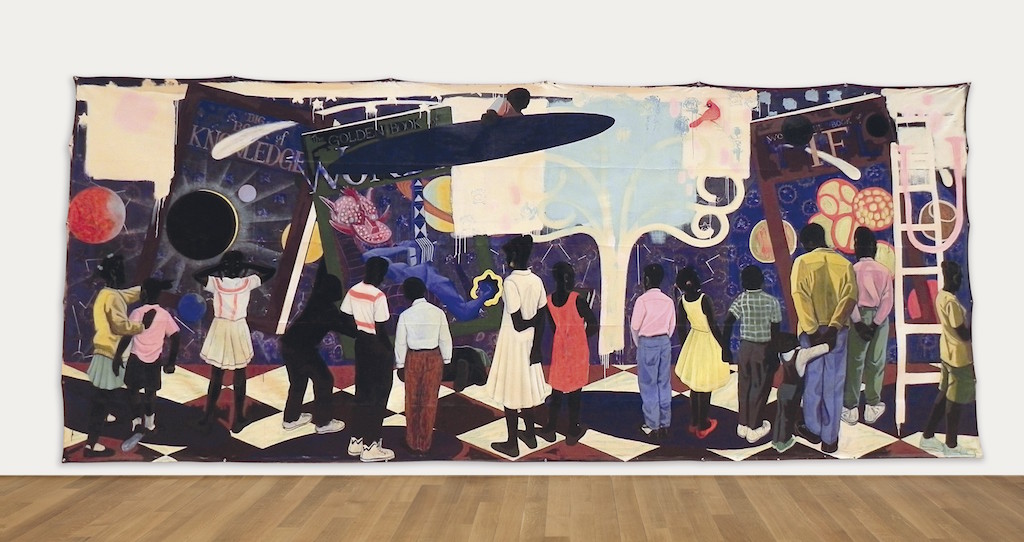[ad_1]

Kerry James Marshall, Knowledge and Wonder, 1995.
CHRISTIE’S IMAGES LTD. 2018
At the opening of his new exhibition at David Zwirner gallery in London, artist Kerry James Marshall commented on the recent decision by the city of Chicago to sell—for a price estimated between $10 million and $15 million by Christie’s in New York, where it will go to auction this fall—a mural he created for a branch of the Chicago Public Library.
“I am certain they could get more money if they sold the Picasso sculpture in Daley Plaza,” Marshall said in a comment that was shared with ARTnews. “Considering that only last year Mayor [Rahm] Emanuel and Commissioner [of the Department of Cultural Affairs Mark] Kelly dedicated another mural I designed downtown for which I was asked to accept one dollar, you could say the City of Big Shoulders has wrung every bit of value they could from the fruits of my labor.” (That other mural of Marshall’s is a large work, measuring 132 by 100 feet, now on the facade of the Chicago Cultural Center.)
By coincidence, several paintings in Marshall’s Zwirner exhibition depict artists’ names next to their auction prices, in the style of a supermarket circular.
The city plans to use the funds from Marshall’s library mural, Knowledge and Wonder (1995), to upgrade the branch where it has long been on display, the Legler Library, and turn it back into a regional library. (In 1977, the Legler was decommissioned and made a regular library branch.) According to an article in the Chicago Tribune, the sale of the painting would support “longer hours, significantly more services and programs for adults and children, and collections unique to the surrounding West Side community.” Additional services could include a new STEM-focused children’s library, studio space for an artist-in-residence program, and a sound studio for teens. The money would also go toward Chicago’s public art program.
The Tribune reported that Brian Bannon, Chicago’s library commissioner, said that “city officials have shared their plans with Marshall and that he is supportive.” However, the article added that at press time, “Marshall could not be reached for comment.”
Bannon said the library is not equipped to maintain and secure the painting, which was commissioned for $10,000 in 1993 as part of the Chicago’s “Percent for Art” program. The mural depicts a group of figures, 15 in all, in front of a panorama of books as well as things like planets and molecules and shooting stars. A ladder in the painting has been said to represent the notion of higher learning.
Since it was announced on Monday, the city’s plan has met with controversy. Earlier on Wednesday, the Art Newspaper ran a story quoting figures in Chicago who are critical of the move. Lisa Yun Lee, a professor of art history at the University of Illinois and the director of the National Public Building Museum in Chicago, told the paper, “This is not right. Someone should buy it and give it back to Legler on a long-term loan and then work with AAM [American Alliance of Museums] to stop public art theft through these acts of deaccessioning.” In the same article, Barbara Koenen, a longtime veteran of Chicago’s cultural affairs department, suggested that the city should sell instead Richard Serra’s Reading Cones sculpture currently at home in Grant Park. Of Serra’s work, Koenen said, “He has no connection to Chicago and the city has never known where to put it. It would be happy somewhere else.”
In an interview with ARTnews on Monday, Madeline Grynsztejn, director of the Museum of Contemporary Art Chicago, said, “I’m of two minds about this. It always hurts to see a unique and singular and important piece of our culture leave the city. Having said that, I really appreciate that the funds have been specifically designated to benefit the city’s public art fund as well as the library, and the context for Kerry’s work has really changed from the time he produced this mural. I can imagine that whereas, in the past, the library was in a position to take care of a mural by a local artist, it may not be in a position to preserve and secure work that is now of $10 million to $15 million value.”
Grynsztejn continued: “It would be wonderful if there was thought around funneling those funds to someone who might represent the next generation of artists like Kerry who broaden the diversity and the understanding of this community.” She also added: “It would be amazing if this painting was acquired by a public venue. This is where the churn of the market takes precedence over all other criteria. The larger question is: what happens to culture when important works of art that provide anchors for our citizens go into the private domain and become less visible, if not disappear?”
In an article in the Chicago Sun Times, Civic Federation president Laurence Msall criticized the planned sale on the basis of its not being “tied to an operating plan.” He added, “There is no recurring revenue that the city or the library has identified as to how those services will be paid for. This is, at best, a one-time asset sale. If the decision is made to take this community asset out of the neighborhood, the money should be for longer-term investments—not operating expenses.”
In a related editorial, however, the Sun Times came out in support of the plan: “What makes this trade-off work—a painting for a better library—is that the painting’s value has shot up.” Noting the sale at auction of another of Marshall’s paintings—Past Times, which Chicago’s Metropolitan Pier and Exposition Authority bought in 1997 for $25,000 and sold this year for $21.1 million—the editorial suggested that Knowledge and Wonder‘s “skyrocketing value raises concerns that it can’t be properly protected from theft or damage. A library has nowhere near the security measures of an art museum.”
[ad_2]
Source link

